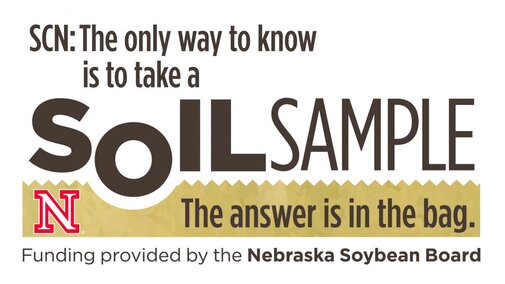Growers frequently ask about why we need to sample for soybean cyst nematodes or SCN, a pest causing more yield losses than all other soybean diseases combined. As harvest winds down, we are entering the time when the most samples are taken each year. This prompted a related question on sampling: What is the proper way to take a soil sample to test for SCN in your field?
There is both science and art in collecting good soil samples.
The Science: How to Take an SCN Sample

The science part of sampling for SCN is pretty easy:
- Take your sample from an area no larger than 40 acres. Less is better.
- Clean your soil probe and the bucket used to collect the soil cores between fields to avoid contaminating other samples from one SCN-positive field.
- Take a minimum of 20 to 25 soil cores randomly across the area being tested.
- If sampling a field with standing soybean stubble, take soil cores 6 to 8 inches deep, just a couple inches to the side of the old soybean row so you’ll be probing through the root system and more likely to detect SCN if it is there.
- If sampling a field that wasn’t in soybeans this year, randomly collect samples across the area to be tested. Consider these results, from fields that will be planted to soybeans next year, when ordering varieties with or without SCN resistance for the next year.
- If a co-op, crop consultant, or field scout will be soil sampling your fields for fertilizer recommendations, ask them to take a few more cores, mix them together, then split the sample, half for fertilizer recommendations and half for SCN analysis.
- Thoroughly mix the cores you collect and submit the soil sample in special bags available at your local Nebraska Extension office for a free SCN analysis. The cost of the analysis (normally $20/sample) is being paid by the Nebraska Soybean Board from your Soybean Checkoff dollars. Submit your sample(s) to the Plant and Pest Diagnostic Clinic, whose address is on the bag.
The Art: Selecting Areas to Provide Accurate Field Samples
When selecting field areas to sample, it’s important to remember anything that will move soil will also move SCN, including wind, water, wildlife and humans, as well as equipment.
Now here comes the “art” part of collecting your soil samples for SCN. Knowing that SCN moves with soil, determine areas where soil may have moved and SCN may have become established.
Following are areas where you will want to take a couple cores:
- Along a stream that periodically floods. Someone upstream might have had SCN in a field and it washed down to your field.
- Low areas where water drains after a heavy rain. Light infestations throughout the field may be concentrated in these low areas where water stands.
- Along fence lines. In the past when fall tillage was more common, fences would act like a trip for the blowing soil and SCN could be deposited along old fencerows.
- By field entryways or driveways. This is the most likely place for soil from another SCN-infested field to be shaken loose from equipment moving in the new field.
Two other areas should be sampled:
- Field areas with a higher incidence of sudden death syndrome (SDS) or brown stem rot (BSR). You can have either of these diseases without having SCN... or you can have SCN without having either of these diseases, but if you have SCN in a field or even part of a field, you are more likely to have SDS or BSR.
- Areas where your observations or yield maps indicate soybean yields are not meeting expectations. This might be a whole field, but more commonly it is an area in the field. A statement such as “The west end of my field isn’t yielding like the rest of the field and there is not a difference in soil type, compaction, herbicide injury, weed or insect pressure... or other explanation for lower soybean yields. Also, when I plant corn, yields are good across the whole field!” can be the perfect indicator of where to sample for SCN.
In both of these cases — areas with higher SDS/BSR or where yields didn’t meet expectations — take a soil sample where these conditions existed and another sample close by where disease pressure was lower or yields met expectations. The results can help you confirm or eliminate SCN as the culprit causing the disease pressure or lower yields.
If both samples come back high for SCN, you know you have SCN and need to manage it, plus you know you have some other condition contributing to these problems. If the SDS/BSR or low-yielding areas come back high for SCN and the adjacent area comes back low, SCN is the problem. You can now start your management plan to lower the level of SCN in your field.
Resources
For more information on sampling for or managing SCN:
- see Soybean Cyst Nematode in the Plant Disease Management section of CropWatch,
- find related stories at the soybean cyst nematode topic tag or
- contact your local Nebraska Extension office.

